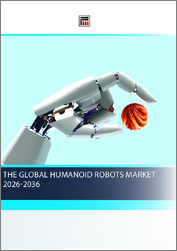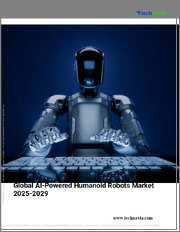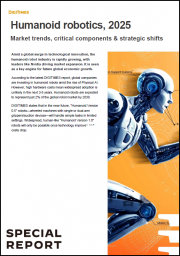
|
시장보고서
상품코드
1722126
세계의 휴머노이드 로봇 시장 : 용도, 구성요소, 모션, 지역별 분석과 예측(2025-2034년)Humanoid Robot Market - A Global and Regional Analysis: Focus on Application, Component, Motion, and Region - Analysis and Forecast, 2025-2034 |
||||||
휴머노이드 로봇 산업은 크게 세 가지 주요 부문으로 나뉩니다.
우선 업스트림 부문에서는 프레임리스 토크 모터 및 중공 컵 모터, 정밀 감속기, 고에너지 밀도 배터리, 첨단 센서(비전, LiDAR, 힘/토크 센서), 전용 AI 프로세서, 고밀도 인쇄회로기판(PCB) 등 주요 구성품이 공급됩니다. 공급합니다. 미드스티림 부문에서는 Boston Dynamics, Tesla, Agility Robotics 등의 제조업체가 이러한 부품을 통합하여 전체 휴머노이드 로봇 플랫폼을 구축합니다. 다운스트림 부문에서는 시스템 통합업체와 최종사용자에 의해 제조업, 물류, 교육, 의료, 서비스업 등 각 분야에서 도입 및 활용이 이루어지고 있습니다.
기술적으로는 고토크-경량비를 실현하는 전동 액추에이션 기술, 멀티모달 인식 센서 배열, ROS(Robot Operating System) 기반 제어 소프트웨어에 대규모 언어 모델과 디지털 트윈 시뮬레이션을 결합한 AI 구동 제어 기술의 발전으로 로봇의 적응성, 자율성, 안전성이 크게 향상되고 있습니다. 또한, 클라우드 로보틱스 프레임워크를 통해 OTA를 통한 소프트웨어 업데이트, 원격 차량 모니터링, 로봇 간 집단 학습이 가능해져 기능 향상 가속화와 도입 리스크 감소를 실현하고 있습니다.
| 주요 시장 통계 | |
|---|---|
| 예측 기간 | 2025-2034년 |
| 2025년 평가 | 29억 7,000만 달러 |
| 2034년 예측 | 159억 8,000만 달러 |
| CAGR | 20.56% |
현재 휴머노이드 로봇 시장은 성장 초기 단계에 있으며, 시험 도입 단계를 넘어 본격적인 상용화로 전환하고 있습니다. 이 단계는 2025년까지 50% 이상의 전년 대비 성장률, 로봇 분야의 선구자들과 산업용 OEM과의 전략적 제휴 증가, 벤처 투자 및 특허 출원 증가 등의 추세로 뒷받침되고 있습니다. 자율성의 신뢰성, 시스템 안전성, 총소유비용(TCO)과 같은 주요 장벽이 점차 극복되면서 2020년대 후반에는 이 시장이 보다 성숙한 성장 단계로 진입할 것으로 예상됩니다. 이에 따라 교육, 의료, 서비스 분야로의 도입이 확대되고 경쟁 환경도 다양화될 것으로 보입니다.
세계의 휴머노이드 로봇 시장을 조사했으며, 주요 동향, 시장 영향요인 분석, 법·규제 환경, 기술·특허 동향, 사례 분석, 시장 규모 추정 및 예측, 각종 부문별·지역별·주요 국가별 상세 분석, 경쟁 구도, 주요 기업 개요 등의 정보를 정리하여 전해드립니다.
목차
주요 요약
제1장 시장 : 업계 전망
- 동향 : 현황과 향후에 대한 영향 평가
- 이해관계자 분석
- 사용 사례
- 최종사용자와 구입 기준
- 시장 역학 개요
- 시장 성장 촉진요인
- 시장 성장 억제요인
- 시장 기회
- 규제 및 정책 영향 분석
- 특허 분석
- 스타트업 상황
- 총잠재 시장
- 투자 상황과 연구개발 동향
- 향후 전망과 시장 로드맵
- 밸류체인 분석
- 세계의 가격 분석
- 업계의 매력
제2장 휴머노이드 로봇 시장 : 용도별
- 용도 세분화
- 용도 요약
- 휴머노이드 로봇 시장(용도별)
- 조사·우주 탐사
- 교육·엔터테인먼트
- 퍼스널 어시스턴스·간병
- 호스피탈리티
- 수색 구조
- 기타
제3장 휴머노이드 로봇 시장 : 제품별
- 제품 세분화
- 제품 요약
- 휴머노이드 로봇 시장(구성요소별)
- 하드웨어
- 소프트웨어
- 서비스
- 휴머노이드 로봇 시장(모션별)
- 이족 보행
- 휠 구동
제4장 휴머노이드 로봇 시장 : 지역별
- 휴머노이드 로봇 시장(지역별)
- 북미
- 지역 개요
- 시장 성장 원동력
- 시장 과제
- 주요 기업
- 용도
- 제품
- 북미(국가별)
- 유럽
- 지역 개요
- 시장 성장 원동력
- 시장 과제
- 주요 기업
- 용도
- 제품
- 유럽(국가별)
- 아시아태평양
- 지역 개요
- 시장 성장 원동력
- 시장 과제
- 주요 기업
- 용도
- 제품
- 아시아태평양(국가별)
- 기타 지역
- 지역 개요
- 시장 성장 원동력
- 시장 과제
- 주요 기업
- 용도
- 제품
- 기타 지역(지역별)
제5장 시장 - 경쟁 벤치마킹과 기업 개요
- 다음 프론티어
- 지리적 평가
- 기업 개요
- Softbank Robotics Group
- Robotis
- Ubtech Robotics Corp Ltd.
- PAL Robotics
- Agility Robotics
- Kawada Robotics Corporation
- Toyota Motor Corporation
- Honda Motor Co., Ltd.
- Hason Robotics Ltd.
- Hyulium Robot
- SAMSUNG
- TESLA
- 기타 주요 기업
제6장 조사 방법
ksm 25.05.28Global Humanoid Robot Market: Industry Overview
The humanoid robotics industry is structured into three key segments: an upstream tier supplying core components, frameless torque and hollow?cup motors, precision reducers, power?dense batteries, advanced sensors (vision, LiDAR, force/torque), specialized AI processors, and high?density PCBs; a midstream tier where manufacturers (e.g., Boston Dynamics, Tesla, Agility Robotics) integrate these elements into complete humanoid platforms; and a downstream tier encompassing system integrators and end-use deployments across manufacturing, logistics, education, healthcare, and service sectors. Technologically, advances in electric actuation (delivering high torque?to?weight ratios), multi-modal perception arrays, and AI-driven control software, often built on ROS architectures and augmented by large-language models and digital twin simulations, are significantly enhancing robot adaptability, autonomy, and safety. Complementing on-board intelligence, cloud-robotics frameworks now enable over-the-air software updates, remote fleet monitoring, and collective learning, accelerating capability improvements and reducing deployment risk.
Humanoid Robot Market Lifecycle Stage
| KEY MARKET STATISTICS | |
|---|---|
| Forecast Period | 2025 - 2034 |
| 2025 Evaluation | $2.97 Billion |
| 2034 Forecast | $15.98 Billion |
| CAGR | 20.56% |
Currently, the humanoid robot market is in a pronounced early growth stage, moving beyond pilot deployments into scaled commercial roll-outs. This phase is evidenced by high year-on-year growth rates (over 50% through 2025) and increasing venture funding, patent filings, and strategic alliances between robotics pioneers and industrial OEMs. As key barriers-such as autonomy reliability, system safety, and total cost of ownership-are incrementally overcome, the market is expected to transition into a more mature growth phase by the late 2020s, with broader adoption across education, healthcare, and service sectors fostering a diversified competitive landscape.
Humanoid Robot Market Segmentation:
Segmentation 1: by Application
- Research and Space Exploration
- Education and Entertainment
- Personal Assistance and Caregiving
- Hospitality
- Search & Rescue
- Others
Personal Assistance and Caregiving is one of the prominent application segments in the global humanoid robot market.
Segmentation 2: by Component
- Hardware
- Sensors
- Actuators
- Power Systems
- Control Systems/Controllers
- Others
- Software
- Services
The global humanoid robot market is estimated to be led by the software based segment in terms of component.
Segmentation 3: by Motion
- Biped
- Wheel-drive
Segmentation 4: by Region
- North America - U.S., Canada, and Mexico
- Europe - Germany, France, Italy, Spain, U.K., and Rest-of-Europe
- Asia-Pacific - China, Japan, South Korea, India, and Rest-of-Asia-Pacific
- Rest-of-the-World - South America and Middle East and Africa
In the humanoid robot market, North America is anticipated to gain traction in terms of production, with increasing infrastructure demand and govement initiatives.
Demand - Drivers and Limitations
The following are the demand drivers for the global humanoid robot market:
- Increasing Demand for Humanoids in Educational Sector
The global humanoid robot market is expected to face some limitations as well due to the following challenges:
- Performance Limitations of Humanoid Robots
Humanoid Robot Market Key Players and Competition Synopsis
The humanoid robot market is characterized by intense competition among specialized robotics firms and major technology and automotive entrants. Leading vendors include SoftBank Robotics, Agility Robotics, Boston Dynamics, UBTECH Robotics, Pal Robotics, Hanson Robotics and ROBOTIS, alongside automotive-backed initiatives from Tesla, Toyota and Hyundai. These players differentiate through advanced AI-driven autonomy, payload capacity, human-robot interaction interfaces and safety certifications, while strategic partnerships with manufacturers, logistics providers and research institutions bolster deployment pipelines. Concurrently, substantial venture funding, patent activity and mergers particularly between U.S. innovators and Chinese hardware manufacturers-underscore a race to capture growing demand across industrial, service and educational applications.
Some of the prominent established names in this market are:
- Softbank Robotics Group
- Robotis
- Ubtech Robotics Corp Ltd.
- PAL Robotics
- Agility Robotics
- Kawada Robotics Corporation
- Toyota Motor Corporation
- Honda Motor Co., Ltd
- Hason Robotics Ltd.
- Hyulium Robot
- SAMSUNG
- TESLA
Companies that are not a part of the previously mentioned pool have been well represented across different sections of the report (wherever applicable).
Table of Contents
Executive Summary
Scope and Definition
Market/Product Definition
Key Questions Answered
Analysis and Forecast Note
1. Markets: Industry Outlook
- 1.1 Trends: Current and Future Impact Assessment
- 1.2 Stakeholder Analysis
- 1.2.1 Use Case
- 1.2.2 End User and Buying Criteria
- 1.3 Market Dynamics Overview
- 1.3.1 Market Drivers
- 1.3.2 Market Restraints
- 1.3.3 Market Opportunities
- 1.4 Regulatory & Policy Impact Analysis
- 1.5 Patent Analysis
- 1.6 Start-Up Landscape
- 1.7 Total Addressable Market
- 1.8 Investment Landscape and R&D Trends
- 1.9 Future Outlook and Market Roadmap
- 1.10 Value Chain Analysis
- 1.11 Global Pricing Analysis
- 1.12 Industry Attractiveness
2. Humanoid Robot Market (by Application)
- 2.1 Application Segmentation
- 2.2 Application Summary
- 2.3 Humanoid Robot Market (by Application)
- 2.3.1 Research and Space Exploration
- 2.3.2 Education and Entertainment
- 2.3.3 Personal Assistance and Caregiving
- 2.3.4 Hospitality
- 2.3.5 Search & Rescue
- 2.3.6 Others
3. Humanoid Robot Market (by Product)
- 3.1 Product Segmentation
- 3.2 Product Summary
- 3.3 Humanoid Robot Market (by Component)
- 3.3.1 Hardware
- 3.3.1.1 Sensors
- 3.3.1.2 Actuators
- 3.3.1.3 Power Systems
- 3.3.1.4 Control Systems/Controllers
- 3.3.1.5 Others
- 3.3.2 Software
- 3.3.3 Services
- 3.3.1 Hardware
- 3.4 Humanoid Robot Market (by Motion)
- 3.4.1 Biped
- 3.4.2 Wheel-drive
4. Humanoid Robot Market (by Region)
- 4.1 Humanoid Robot Market (by Region)
- 4.2 North America
- 4.2.1 Regional Overview
- 4.2.2 Driving Factors for Market Growth
- 4.2.3 Factors Challenging the Market
- 4.2.4 Key Companies
- 4.2.5 Application
- 4.2.6 Product
- 4.2.7 North America (by Country)
- 4.2.7.1 U.S.
- 4.2.7.1.1 Market by Application
- 4.2.7.1.2 Market by Product
- 4.2.7.2 Canada
- 4.2.7.2.1 Market by Application
- 4.2.7.2.2 Market by Product
- 4.2.7.3 Mexico
- 4.2.7.3.1 Market by Application
- 4.2.7.3.2 Market by Product
- 4.2.7.1 U.S.
- 4.3 Europe
- 4.3.1 Regional Overview
- 4.3.2 Driving Factors for Market Growth
- 4.3.3 Factors Challenging the Market
- 4.3.4 Key Companies
- 4.3.5 Application
- 4.3.6 Product
- 4.3.7 Europe (by Country)
- 4.3.7.1 Germany
- 4.3.7.1.1 Market by Application
- 4.3.7.1.2 Market by Product
- 4.3.7.2 France
- 4.3.7.2.1 Market by Application
- 4.3.7.2.2 Market by Product
- 4.3.7.3 Italy
- 4.3.7.3.1 Market by Application
- 4.3.7.3.2 Market by Product
- 4.3.7.4 Spain
- 4.3.7.4.1 Market by Application
- 4.3.7.4.2 Market by Product
- 4.3.7.5 U.K.
- 4.3.7.5.1 Market by Application
- 4.3.7.5.2 Market by Product
- 4.3.7.6 Rest-of-Europe
- 4.3.7.6.1 Market by Application
- 4.3.7.6.2 Market by Product
- 4.3.7.1 Germany
- 4.4 Asia-Pacific
- 4.4.1 Regional Overview
- 4.4.2 Driving Factors for Market Growth
- 4.4.3 Factors Challenging the Market
- 4.4.4 Key Companies
- 4.4.5 Application
- 4.4.6 Product
- 4.4.7 Asia-Pacific (by Country)
- 4.4.7.1 China
- 4.4.7.1.1 Market by Application
- 4.4.7.1.2 Market by Product
- 4.4.7.2 Japan
- 4.4.7.2.1 Market by Application
- 4.4.7.2.2 Market by Product
- 4.4.7.3 India
- 4.4.7.3.1 Market by Application
- 4.4.7.3.2 Market by Product
- 4.4.7.4 South Korea
- 4.4.7.4.1 Market by Application
- 4.4.7.4.2 Market by Product
- 4.4.7.5 Rest-of-Asia-Pacific
- 4.4.7.5.1 Market by Application
- 4.4.7.5.2 Market by Product
- 4.4.7.1 China
- 4.5 Rest-of-the-World
- 4.5.1 Regional Overview
- 4.5.2 Driving Factors for Market Growth
- 4.5.3 Factors Challenging the Market
- 4.5.4 Key Companies
- 4.5.5 Application
- 4.5.6 Product
- 4.5.7 Rest-of-the-World (by Region)
- 4.5.7.1 South America
- 4.5.7.1.1 Market by Application
- 4.5.7.1.2 Market by Product
- 4.5.7.2 Middle East and Africa
- 4.5.7.2.1 Market by Application
- 4.5.7.2.2 Market by Product
- 4.5.7.1 South America
5. Markets - Competitive Benchmarking & Company Profiles
- 5.1 Next Frontiers
- 5.2 Geographic Assessment
- 5.3 Company Profiles
- 5.3.1 Softbank Robotics Group
- 5.3.1.1 Overview
- 5.3.1.2 Top Products/Product Portfolio
- 5.3.1.3 Top Competitors
- 5.3.1.4 Target Customers
- 5.3.1.5 Key Personnel
- 5.3.1.6 Analyst View
- 5.3.1.7 Market Share
- 5.3.2 Robotis
- 5.3.2.1 Overview
- 5.3.2.2 Top Products/Product Portfolio
- 5.3.2.3 Top Competitors
- 5.3.2.4 Target Customers
- 5.3.2.5 Key Personnel
- 5.3.2.6 Analyst View
- 5.3.2.7 Market Share
- 5.3.3 Ubtech Robotics Corp Ltd.
- 5.3.3.1 Overview
- 5.3.3.2 Top Products/Product Portfolio
- 5.3.3.3 Top Competitors
- 5.3.3.4 Target Customers
- 5.3.3.5 Key Personnel
- 5.3.3.6 Analyst View
- 5.3.3.7 Market Share
- 5.3.4 PAL Robotics
- 5.3.4.1 Overview
- 5.3.4.2 Top Products/Product Portfolio
- 5.3.4.3 Top Competitors
- 5.3.4.4 Target Customers
- 5.3.4.5 Key Personnel
- 5.3.4.6 Analyst View
- 5.3.4.7 Market Share
- 5.3.5 Agility Robotics
- 5.3.5.1 Overview
- 5.3.5.2 Top Products/Product Portfolio
- 5.3.5.3 Top Competitors
- 5.3.5.4 Target Customers
- 5.3.5.5 Key Personnel
- 5.3.5.6 Analyst View
- 5.3.5.7 Market Share
- 5.3.6 Kawada Robotics Corporation
- 5.3.6.1 Overview
- 5.3.6.2 Top Products/Product Portfolio
- 5.3.6.3 Top Competitors
- 5.3.6.4 Target Customers
- 5.3.6.5 Key Personnel
- 5.3.6.6 Analyst View
- 5.3.6.7 Market Share
- 5.3.7 Toyota Motor Corporation
- 5.3.7.1 Overview
- 5.3.7.2 Top Products/Product Portfolio
- 5.3.7.3 Top Competitors
- 5.3.7.4 Target Customers
- 5.3.7.5 Key Personnel
- 5.3.7.6 Analyst View
- 5.3.7.7 Market Share
- 5.3.8 Honda Motor Co., Ltd.
- 5.3.8.1 Overview
- 5.3.8.2 Top Products/Product Portfolio
- 5.3.8.3 Top Competitors
- 5.3.8.4 Target Customers
- 5.3.8.5 Key Personnel
- 5.3.8.6 Analyst View
- 5.3.8.7 Market Share
- 5.3.9 Hason Robotics Ltd.
- 5.3.9.1 Overview
- 5.3.9.2 Top Products/Product Portfolio
- 5.3.9.3 Top Competitors
- 5.3.9.4 Target Customers
- 5.3.9.5 Key Personnel
- 5.3.9.6 Analyst View
- 5.3.9.7 Market Share
- 5.3.10 Hyulium Robot
- 5.3.10.1 Overview
- 5.3.10.2 Top Products/Product Portfolio
- 5.3.10.3 Top Competitors
- 5.3.10.4 Target Customers
- 5.3.10.5 Key Personnel
- 5.3.10.6 Analyst View
- 5.3.10.7 Market Share
- 5.3.11 SAMSUNG
- 5.3.11.1 Overview
- 5.3.11.2 Top Products/Product Portfolio
- 5.3.11.3 Top Competitors
- 5.3.11.4 Target Customers
- 5.3.11.5 Key Personnel
- 5.3.11.6 Analyst View
- 5.3.11.7 Market Share
- 5.3.12 TESLA
- 5.3.12.1 Overview
- 5.3.12.2 Top Products/Product Portfolio
- 5.3.12.3 Top Competitors
- 5.3.12.4 Target Customers
- 5.3.12.5 Key Personnel
- 5.3.12.6 Analyst View
- 5.3.12.7 Market Share
- 5.3.1 Softbank Robotics Group
- 5.4 Other Key Companies



















